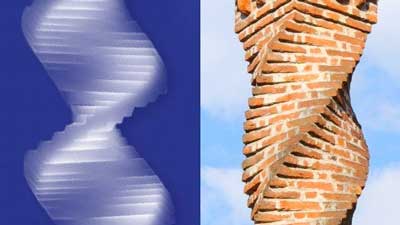| Jul 10, 2019 | |
Giving nanowires a DNA-like twist(Nanowerk News) We see crystals all around us: snowflakes, ice cubes, table salt, gemstones, to name a few. Invisible to the naked eye, but of special interest to scientists, are crystalline “nanowires” — wires with a diameter of a mere few nanometers and a typical length of a micrometer. |
|
| Normally in a rod-like shape, these wires are an interesting area of worldwide research because of their many potential applications, including semiconductors and miniaturized optical and optoelectronic devices. | |
| As reported in a recent Nature paper ("Helical van der Waals crystals with discretized Eshelby twist"), scientists at the Center for Nanoscale Materials (CNM), a U.S. Department of Energy (DOE) Office of Science User Facility located at Argonne National Laboratory, played a critical role in the discovery of a DNA-like twisted crystal structure created with a germanium sulfide nanowire, also known as a “van der Waals material.” The research was conducted in collaboration with the University of California at Berkeley and Lawrence Berkeley National Laboratory. | |
 |
|
| Helical structure of stacked bricks (right, Shutterstock image) is similar to that produced by giving nanowires an Eshelby twist (left, Lawrence Berkeley National Laboratory image). | |
| The helical DNA-like structure forms spontaneously by giving the nanowire an “Eshelby twist.” Co-first author Jie Wang, a former materials scientist in CNM (now at Thorlabs, Inc.), explained that the term “Eshelby twist” refers to its discoverer, John Eshelby. | |
| While a research associate working at the University of Illinois at Urbana-Champaign in the 1950s, Eshelby conducted an important theoretical analysis of “screw dislocation” in a thin rod. Relating the effect to crystals, Wang noted that the “screw dislocation occurs when stress is applied to a rod shape in which the atoms become rearranged in a helical pattern.” | |
| When applied to a germanium sulfide nanowire, this twisting causes it to elongate and widen into a helical structure. | |
| “It is amazing that these inorganic germanium sulfide nanowires so closely resemble the organic DNA structure,” said co-author Jianguo Wen, a CNM materials scientist. “Nature creates remarkable structures beyond our imagination.” | |
| Also important, added CNM scientist and co-author Dafei Jin, was the finding that the nanostructure automatically divides into segments that resemble helically stacked bricks. These brick-like segments arise from the release of energy as the wire diameter grows from tens of nanometers to micrometers. | |
 |
|
| Micrograph of nanowire with Eshelby twist (inset) spontaneously grown into microscale DNA-like structure. (Image: Lawrence Berkeley National Laboratory) | |
| “The discovered Eshelby twist here offers a new way to engineer nanomaterials,” said Wang. “We can tailor these nanowires in many different ways — twist periods from two to twenty micrometers, lengths up to hundreds of micrometers, and radial dimensions from several hundred nanometers to about ten micrometers.” | |
| By this means, researchers can adjust the electrical and optical properties of the nanowires to optimize performance for different applications. | |
| “This is an important materials discovery,” Wen said. “We are excited to have figured out, using CNM’s high-resolution transmission electron microscope, the dislocation structures that drive the nanowires to have an Eshelby twist.” |
| Source: Argonne National Laboratory | |
|
Subscribe to a free copy of one of our daily Nanowerk Newsletter Email Digests with a compilation of all of the day's news. |
